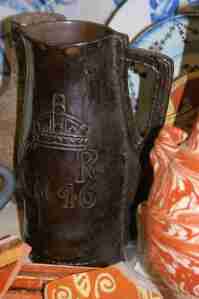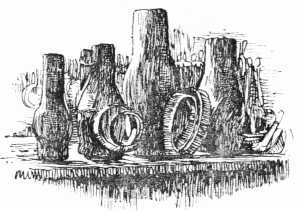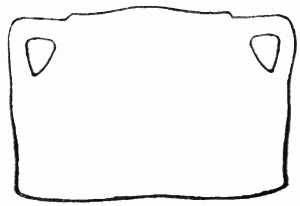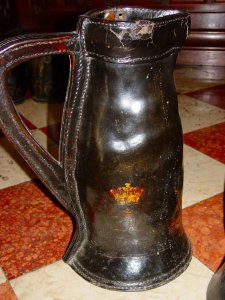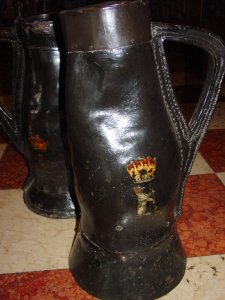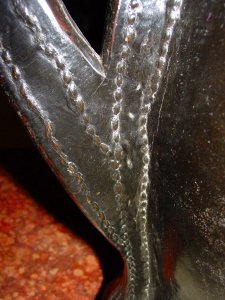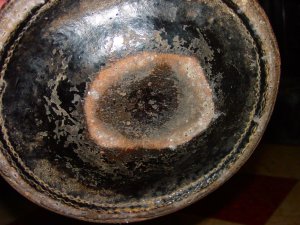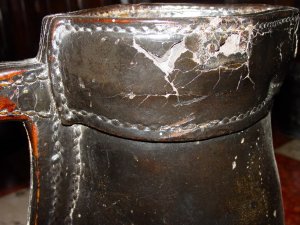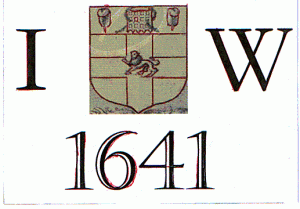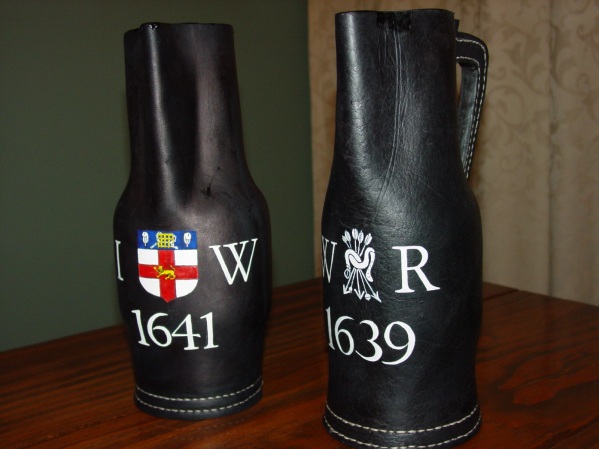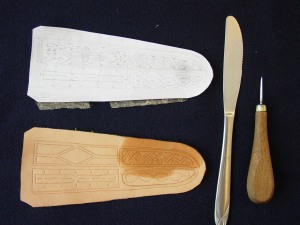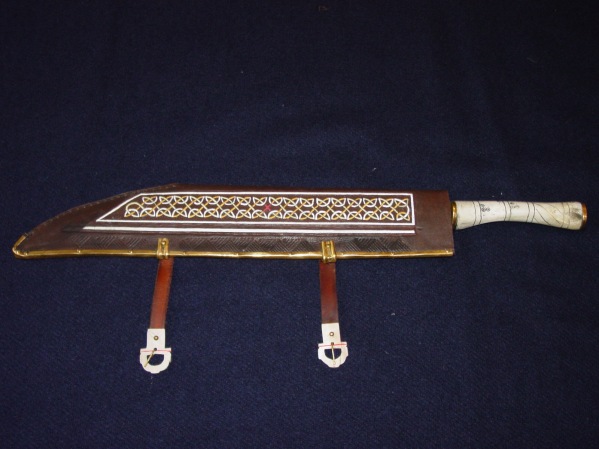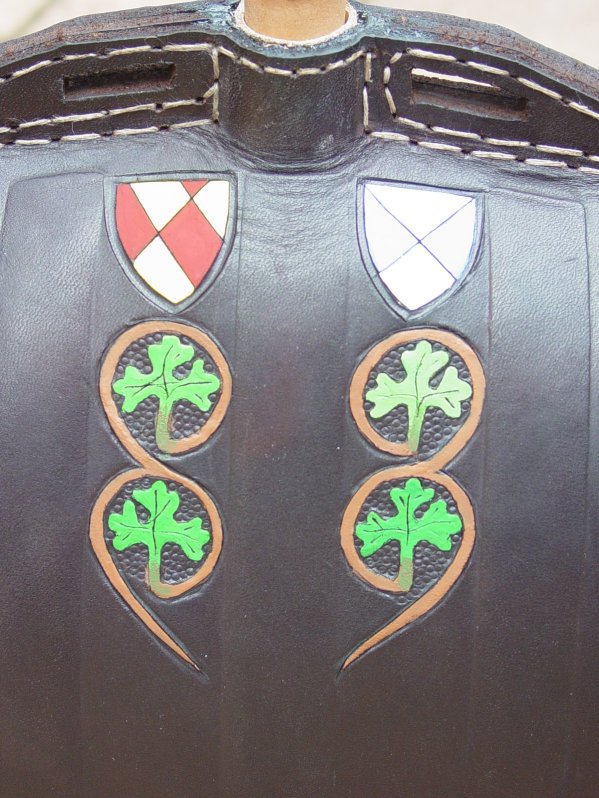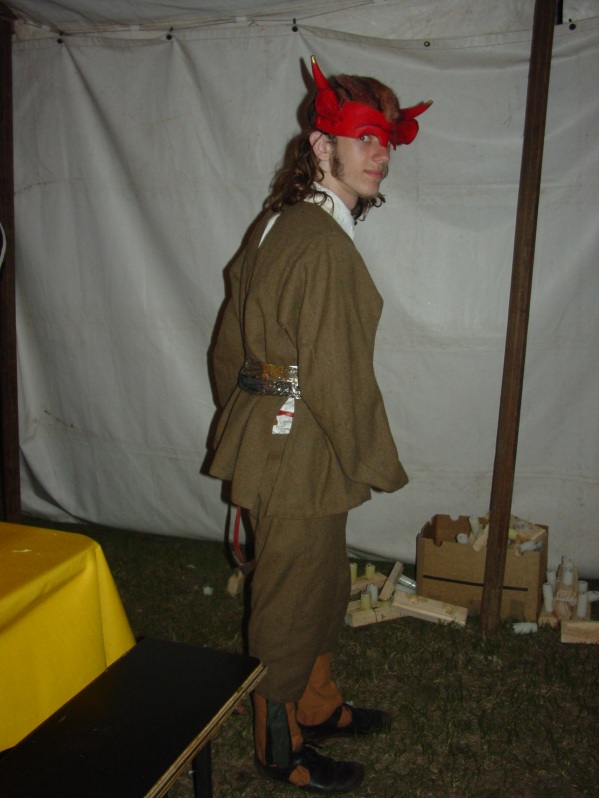So you want to make a black jack… You’ll neet to get the right materials, some equipment and the usual leather working tools. I’ll briefly touch on each of these before going on to discuss manufacture techniques. If you want to open part 1 in another window, you can cross-check the summary of requirements at the bottom to keep me honest.
Materials
I generally make my jacks and bottels from harness butt. It’s about 3.6 to 5mm thick, has a smooth matte surface and moulds exceptionally well. You need a thickish leather that moulds well and hasn’t been heat-treated.
You’ll need some dye, black is traditional. I’ve used a spirit based leather dye in the past, but am considering an iron-based dye for next time. This dye is chemically very similar to the ink Baker mentions, you could use ink, but avoid India inks as they are carbon in suspension and will shed black over everything.
Linen is the best thread to use, being accurate and strong. I have a 23km reel of fine thread I got on e-Bay from a mill that was closing down for not very much money. It is very fine, so I have to use six-ply on jacks. No, you can’t have some, get your own. Make sure you get enough, you’ll probably need to make two-ply if you use the thread that comes on cards in haberdasher or on reels from leather stores. You do that by cutting two equal lengths of thread, give them a moderate coat of wax and then roll them in one direction until they become a single thread. If the thread kinks or forms loops, you’re rolling them too tightly.
Which brings me on to the next item – wax. You can use pure beeswax quite happily, but if you are feeling adventurous, try coad, a 2:1 to 4:1 mixture of pitch and beeswax. The proportions are best worked out by experimentation, beeswax here is fairly soft for most of the year (and occasionally a sad-looking puddle) so I need more pitch. In Europe and North America, more beeswax may be beneficial. Have a look at this thread, but don’t get scared away by the technical detail some of the correspondents go in to. Plain wax works fine.
Equipment
Most of the equipment I use is in this photo below. The only thing missing is a short length of 90mm PVC storm water pipe that takes the place of the outer ring in Baker’s figure 72. If you have a tame blacksmith, by all means get a pair of iron rings made instead and earn bonus points for being hard-core.

Almost everything you need to make a jack.
Clockwise from the front left corner: there’s the wooden disk, 80mm diameter, 20mm thick that I use with the drain pipe as a substitute for Mr Baker’s paired iron rings; the hinged stretching frame, made from 100 x 50mm radiata pine recovered from an old kitchen cabinet (the nine screws in the bottom right corner reinforce a split that runs along the grain); the mould/core turned up for me by a friendly woodturner from an old kauri pine table leg at the cost of approximately 3 beers and; the removable piece for moulding the spout made from offcuts of radiata.

Showing the way the frame boards are cut to match the mould core. ‘Scuse fingers.
Tools
You’ll need the usual implements of terror: harness needles or pig bristles if you can get them; a strong, sharp awl as some places are nearly 20mm thick; a sharp knife with a good point for cutting out the pattern and the handle – I use a Stanley knife/box cutter because I don’t yet have a half-moon knife and; a butter knife or embossing tool if you are going to do the parallel lines around the spout. You may also want some stamps if you are doing any stamped decoration.
Construction
Cutting the leather
Cut the requisite two pieces of leather. The main body piece should rectangular with the short side approximate the desired height of the finished jack and the long side equal to the circumference at the smallest diameter of the mould (near the top on mine) plus the width of the handle on each side, plus a bit extra for banging nails into. The long axis should lie across the hide to gain maximum advantage from the natural stretch of the leather. The other piece is roughly circular, the diameter of the wooden disk, plus at least twice the height. A bit more doesn’t hurt as it will be trimmed to shape later. I tend to hack these out of the odd sticky-out bits near the edge of the hide.
I didn’t do any photos of the cut-out bits, you know what a rectangle of leather looks like and should be able to infer from the later photos anyway.
Forming the base
Soak the leather, then place the wooden disk against the skin side in approximately the middle of the piece and then push the entire assembly into the end of the bit of drain pipe flesh side first. The pipe should compress the leather against the wooden disk, and if the sizes are right, result in a nice sharp transition. This is much the same method as used to form the ends of costrels, but a little easier as you are using a commercially available outer mould. Set aside to dry, the time will vary depending on where you live. If you live somewhere really cold or damp, put it in the oven at it’s lowest temperature for a couple of hours but take care it never approaches 70° C / 155° F as you don’t want the leather to harden. Again, no photos so have a look at the costrel end ones and imagine something similar… but round.
Forming the body
Watch carefully. Because there is some space at the top and bottom, draw some lines on the frame to help align the leather. Wet the leather and nail it in position on the back edge of the frame. This stops the leather stretching unevenly around the nails. If it’s too loose, you can always pry it off and re-nail it a little tighter as I had to on my first one.
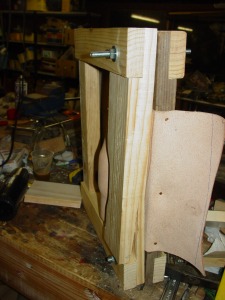
The leather nailed in place and tightened around the former. I left the leather far too long on this first one, the second one was done with a shorter rectangle. You can see the crack in the frame opening up.
Then stuff the core in the middle and clamp, the threaded rods help the frame keep in alignment when tightening, but are probably unnecessary. Once that’s clamped properly and assumed the correct shape, squeeze the spout bit in. I found doing the two parallel lines around the spout with the back of the obligatory butter knife really worked the leather tightly in around the spout. Do any other tooling or stamping at this point.

The spout piece in place.
Once dry, remove loosen the bolts or unclamp and remove the nails and feel smug.

Dried, pried off and feeling smug.
How are we going against Baker’s list? I’ve used two pieces of leather, formed it on a wooden core with a removable spout piece and shaped the base using two iron ring substitutes. We did a little embossing around the spout while still on the core, although its a bit awkward working around the frame. So far so good.
Trimming
Pop the base out of the pipe, keeping the bit of wood inside. Trim the base to between 15 and 20mm high.
Take the body and cut out the handle, cut a couple of handle copies out of the waste. This one has a mid-17th century handle shape consistent with the double embossed lines around the spout.

All the bits cut out. The reinforcing pieces are cut from the waste. I suspect this is the stage Baker based his schematic on.
I’m cheating again. The photo below is from my second attempt at making a jack this way because my first was way too long and had more waste than I was aiming for. Let’s have a quick list check again: started with a single larger piece for the body, cut to shape and cut the reinforcing bits from the waste.

This is the waste from my second attempt. I doubt I could do much better starting from a rectangle.
You’ll need a welt the same height as the base with the length the same as the circumference as the base. I made mine up from several pieces cut from the bigger bits of scrap, beveling the ends so a single stitch could hold both in place. You could also use a separate strip, but I’m trying to stay within the confines of Mr Baker’s list. Now it’s time to dye all the parts (I’ve already done the base in the photo above) and let them dry.
Assembly
There’s not much to tell here, do the back seam first, followed by the seam that runs along the outside of the handle. The closer the back seam is to the crease between the handle and body, the stronger and easier to waterproof the jack will be. Then sew around the inside of the handle, and once done, cut out the centre of the handle.

Back seams done, handle cut and the base sewn in. I haven’t re-dyed the cut edges yet.
Pay close attention to the stitch spacing, and make sure the stitches are perpendicular to the surface. You also need to make sure they are in a straight line on both sides of the handle or it will look ugly and can lead to stitches being cut when you cut out the eye of the handle.

View from underneath showing base, welt and the intersection with the handle reinforcing parts.
Force in the base and welt and secure with two rows of stitching. That’s pretty much it. Do any trimming you need to tidy the edges, then re-dye. Neaten the cut edges by dampening and rubbing with a plastic slicker or piece of bone. I like using lamb bones as they bring the edge to a high gloss.
I usually do the painting at this point, but you can wait until after pitching if you’re worried that the heat will affect the paint.
Sealing
I have a hoard of black brewers’ pitch that I use for bombards and jacks. I generally cover the outside with kitchen foil so any drops of pitch don’t mar the outside or stop the adhesion of the paint. Heat the pitch, pour in, slosh about so everything is covered and pour back in to the pitch pot again. The pitch should be hot enough to be runny, but not smoking. You can build up a good even coating with multiple coats if the first seems too thin. If blisters or runs are causing you problems, a couple of hours back in the oven at 60° C should help even out the surface although it will make everything slump towards the base slightly. Turn the oven off and allow to cool before removing the jack so you don’t craze the pitch. This step simulates the technique of hanging jacks in the smoke of a fire that Waterer talks about in Leather in Life Art and Industry.
Some people prefer to mix wax with the pitch to make it flow or to extend it. That doesn’t work for me as the pitch is soft enough as it is. Others use Envirotex or other food grade epoxy as some jurisdictions consider pitch to be a carcinogen. I’ll leave it up to you, but I think the risk is acceptably low as I use these less than once per month and am exposed to other carcinogens such as plasticisers on a far more regular basis.
Finishing
Varnish over any painting and then give the entire beast a good rub down with a wax furniture polish (or sealing wax dissolved in alcohol).
Summary
That more or less concludes the making of the jack within Mr Baker’s constraints. We’ve formed the base from a single piece of leather, worked over a round former. The body was cut as a single piece of leather, and after moulding around a wooden core with a removable spout piece, the waste around the handle was cut off and made into the reinforcing pieces. Embossing took place while still on the block and the handle wasn’t finished until after the stitching was complete.
I feel I have achieved all the self-imposed requirements based on Baker. My only additional step to those in the book was using a stretching frame. Other more skilled artisans than I may be able to mould a jack around a core with their bare hands, but I find it essential to compensate for my shortcomings and helpful in an early modern period style of mass-production.
I like to kid myself that if my methods approach the historical methods used to do something, my mistakes will resemble their mistakes. Here’s a picture of what uneven stitch tension did to one of my jacks, and to a seventeenth century one in the MoL collection.

This is what uneven tension did for me.

Similar problems in the 17th century. Sorry about the flash. For more information, see the MoL record.

Here’s two I prepared earlier. The one on the right is my first attempt.

